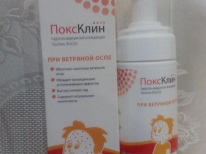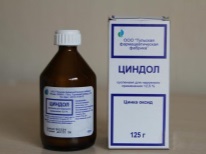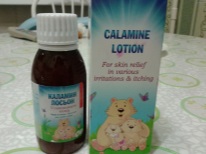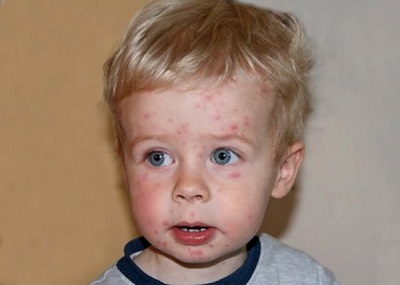Chicken pox without fever in children
Increased body temperature and skin blisters - these symptoms of chickenpox are familiar to anyone who has heard of this childhood infection. And if there is no one of these manifestations of chickenpox, the parents have a completely logical question whether the child has chicken pox. Mothers are always interested in this if a child has a rash, but the temperature has not risen. Does this situation happen in chickenpox and what does it say?
How is chickenpox transmitted
The causative agent of varicella, which belongs to herpes viruses, is transmitted from sick children by droplets to children and adults who do not have immunity to chickenpox. The susceptibility to such a virus is very high (up to 90%), and the pathogen itself is very volatile (can be carried for tens of meters), so anyone who has spent at least 5-15 minutes near a sick person is at risk of contracting chickenpox.
Contagious a child with chickenpox becomes more during the incubation period (on the last day).
Further, it releases the pathogen throughout the acute period, until the rash appears, and also for some time after the last vesicles have formed on the skin (5 days). First signs diseases appear 7-21 days after contact with the source of the virus. On average, chickenpox can begin two weeks after infection.
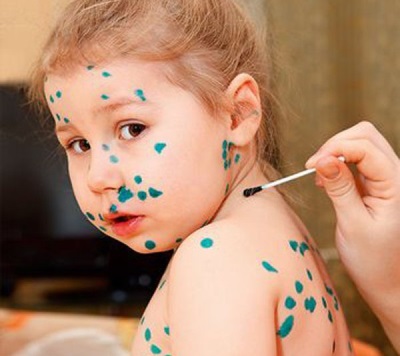
The ill child in most cases acquires strong immunity to chickenpox, that is, no longer suffers from such an infection until the end of life. The recurrence of the disease is extremely rare and usually triggered by immunodeficiency states. However, the virus that causes chickenpox does not leave the body after recovery, but remains in the tissues of the nervous system. In old age, he is able to provoke a disease called "herpes zoster".
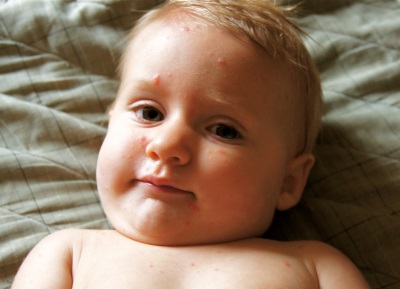
Can there be no temperature?
The course of chicken pox in children aged 2-7 years is most often represented by a mild form. And with such a chickenpox, the body temperature can really not rise. To understand that the baby has got chickenpox, you can use the rash traditional for this infection. It is first represented by small spots that grow very quickly, becoming papules, and then - watery single-chamber vesicles.
Soon such bubbles dry up, becoming covered with crusts, and next can appear new spots, which are also transformed into a bubble rash. Crusty rashes completely heal within 1-2 weeks and, if the child has not combed them and has not brought bacteria into the wounds, they do not leave any traces behind them.
The first elements of the chickenpox rash occur on the skin of the trunk, and then the mother can detect them on the extremities (except for the feet and palms) and on the head. With a light course, the rash is not abundant and can only be represented by one “wave”, that is, rashes appear on the first day of the disease, and no new vesicles form on the next day.
Separately, it should be noted that chickenpox rash is very itchy and itchy. This causes discomfort for the child and causes whims and worsening sleep.
Treatment of mild chickenpox
Flowing without temperature chicken pox treat at home conditionspaying attention gentle diet and plenty of drink. Prepare light and nutritious meals for your child, avoiding spicy, salty and smoked foods.
In addition, the baby with chicken pox should be given more warm liquid, even if the temperature is not elevated. This will help the body cope with the virus faster and avoid complications.
Due to pronounced itching, treating rashes plays a significant role in treating mild chickenpox. The use of various local means helps not only to relieve the itch, but also to dry the bubbles faster and also to prevent their infection.
The traditional for our country Zelenka many modern parents refuse in favor of colorless and more effective means, among which the most demanded are:
However, it is possible to use diamond green in the old fashioned way or its more pleasant looking analogue - fukortsin (pink antiseptic). Such tools do a good job of disinfecting and drying the skin with chickenpox, which counteracts the penetration of harmful bacteria into the affected skin.
It is also worth noting that if you do not want to use any local therapy, nothing terrible will happen - even if you do not lubricate the varicella pimples by any means, they will heal without a trace. Provided that the rules of personal hygiene are followed, and the child will not comb the bubbles.
You can learn more about chickenpox from Dr. Komarovsky’s program.




